7AC002 Accounting and Financial Management Report - Analysis
VerifiedAdded on 2019/09/18
|5
|2083
|368
Report
AI Summary
This report is a comprehensive financial analysis of a chosen PLC, examining its performance using key financial ratios (ROCE, Operating Profit Margin, Asset Turnover, Gearing, Interest Cover, and PE ratio) for 2015 and 2014. It requires calculation of these ratios and contextualization with industry and company data. Furthermore, the report proposes a financing strategy for the company to purchase land and buildings representing 25% of its net assets, justifying the chosen method based on the company's financial position and capital structure. Finally, it critically discusses the relevance and evolution of modern management accounting techniques in the current commercial environment. The assessment criteria focus on the quality of financial analysis, the justification of financing choices, and the critical discussion of management accounting, each weighted equally. The report should adhere to a 6000-word limit, excluding appendices, and utilize the Harvard referencing system.
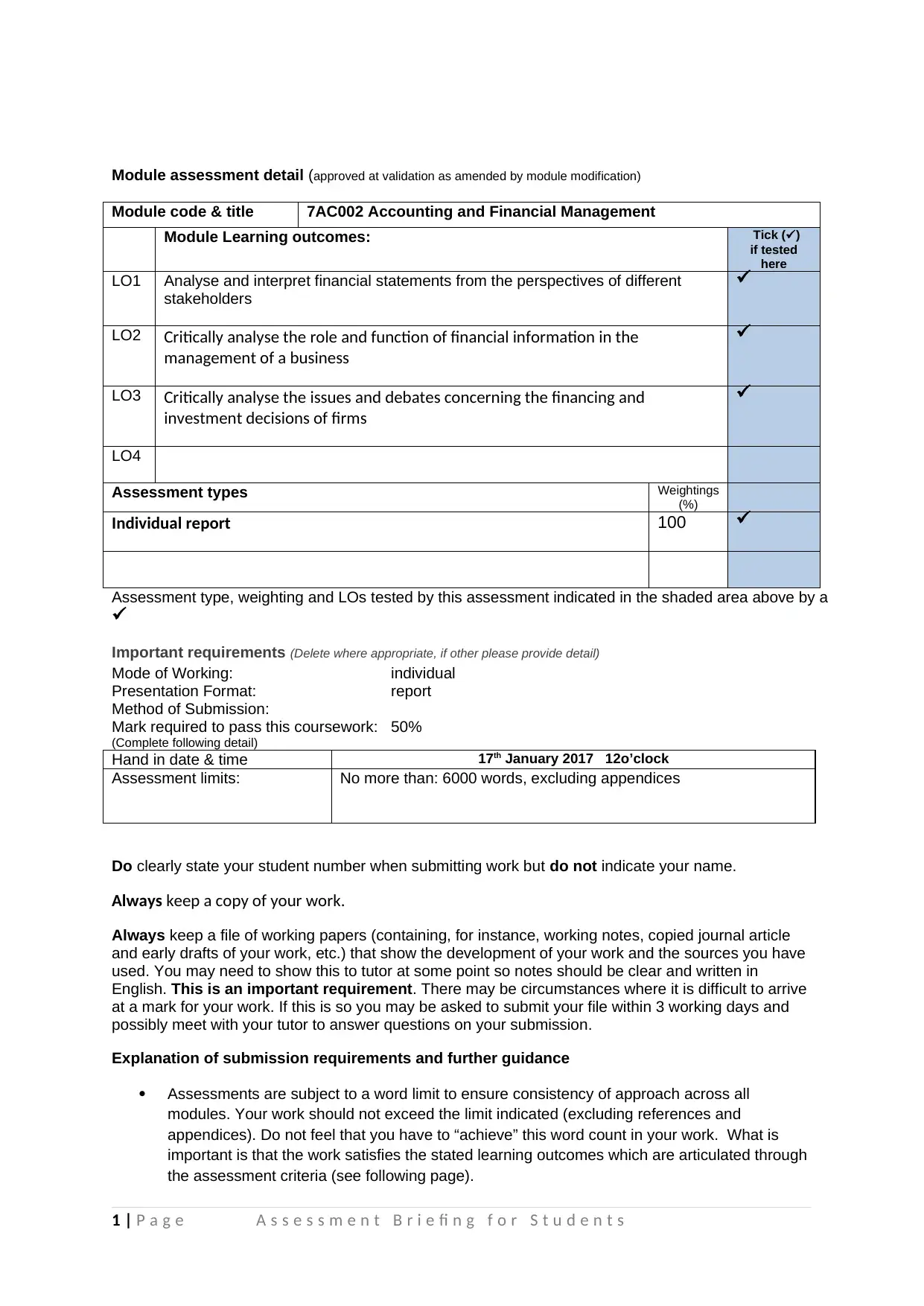
Module assessment detail (approved at validation as amended by module modification)
Module code & title 7AC002 Accounting and Financial Management
Module Learning outcomes: Tick ()
if tested
here
LO1 Analyse and interpret financial statements from the perspectives of different
stakeholders
LO2 Critically analyse the role and function of financial information in the
management of a business
LO3 Critically analyse the issues and debates concerning the financing and
investment decisions of firms
LO4
Assessment types Weightings
(%)
Individual report 100
Assessment type, weighting and LOs tested by this assessment indicated in the shaded area above by a
Important requirements (Delete where appropriate, if other please provide detail)
Mode of Working: individual
Presentation Format: report
Method of Submission:
Mark required to pass this coursework: 50%
(Complete following detail)
Hand in date & time 17th January 2017 12o’clock
Assessment limits: No more than: 6000 words, excluding appendices
Do clearly state your student number when submitting work but do not indicate your name.
Always keep a copy of your work.
Always keep a file of working papers (containing, for instance, working notes, copied journal article
and early drafts of your work, etc.) that show the development of your work and the sources you have
used. You may need to show this to tutor at some point so notes should be clear and written in
English. This is an important requirement. There may be circumstances where it is difficult to arrive
at a mark for your work. If this is so you may be asked to submit your file within 3 working days and
possibly meet with your tutor to answer questions on your submission.
Explanation of submission requirements and further guidance
Assessments are subject to a word limit to ensure consistency of approach across all
modules. Your work should not exceed the limit indicated (excluding references and
appendices). Do not feel that you have to “achieve” this word count in your work. What is
important is that the work satisfies the stated learning outcomes which are articulated through
the assessment criteria (see following page).
1 | P a g e A s s e s s m e n t B r i e fi n g f o r S t u d e n t s
Module code & title 7AC002 Accounting and Financial Management
Module Learning outcomes: Tick ()
if tested
here
LO1 Analyse and interpret financial statements from the perspectives of different
stakeholders
LO2 Critically analyse the role and function of financial information in the
management of a business
LO3 Critically analyse the issues and debates concerning the financing and
investment decisions of firms
LO4
Assessment types Weightings
(%)
Individual report 100
Assessment type, weighting and LOs tested by this assessment indicated in the shaded area above by a
Important requirements (Delete where appropriate, if other please provide detail)
Mode of Working: individual
Presentation Format: report
Method of Submission:
Mark required to pass this coursework: 50%
(Complete following detail)
Hand in date & time 17th January 2017 12o’clock
Assessment limits: No more than: 6000 words, excluding appendices
Do clearly state your student number when submitting work but do not indicate your name.
Always keep a copy of your work.
Always keep a file of working papers (containing, for instance, working notes, copied journal article
and early drafts of your work, etc.) that show the development of your work and the sources you have
used. You may need to show this to tutor at some point so notes should be clear and written in
English. This is an important requirement. There may be circumstances where it is difficult to arrive
at a mark for your work. If this is so you may be asked to submit your file within 3 working days and
possibly meet with your tutor to answer questions on your submission.
Explanation of submission requirements and further guidance
Assessments are subject to a word limit to ensure consistency of approach across all
modules. Your work should not exceed the limit indicated (excluding references and
appendices). Do not feel that you have to “achieve” this word count in your work. What is
important is that the work satisfies the stated learning outcomes which are articulated through
the assessment criteria (see following page).
1 | P a g e A s s e s s m e n t B r i e fi n g f o r S t u d e n t s
Paraphrase This Document
Need a fresh take? Get an instant paraphrase of this document with our AI Paraphraser
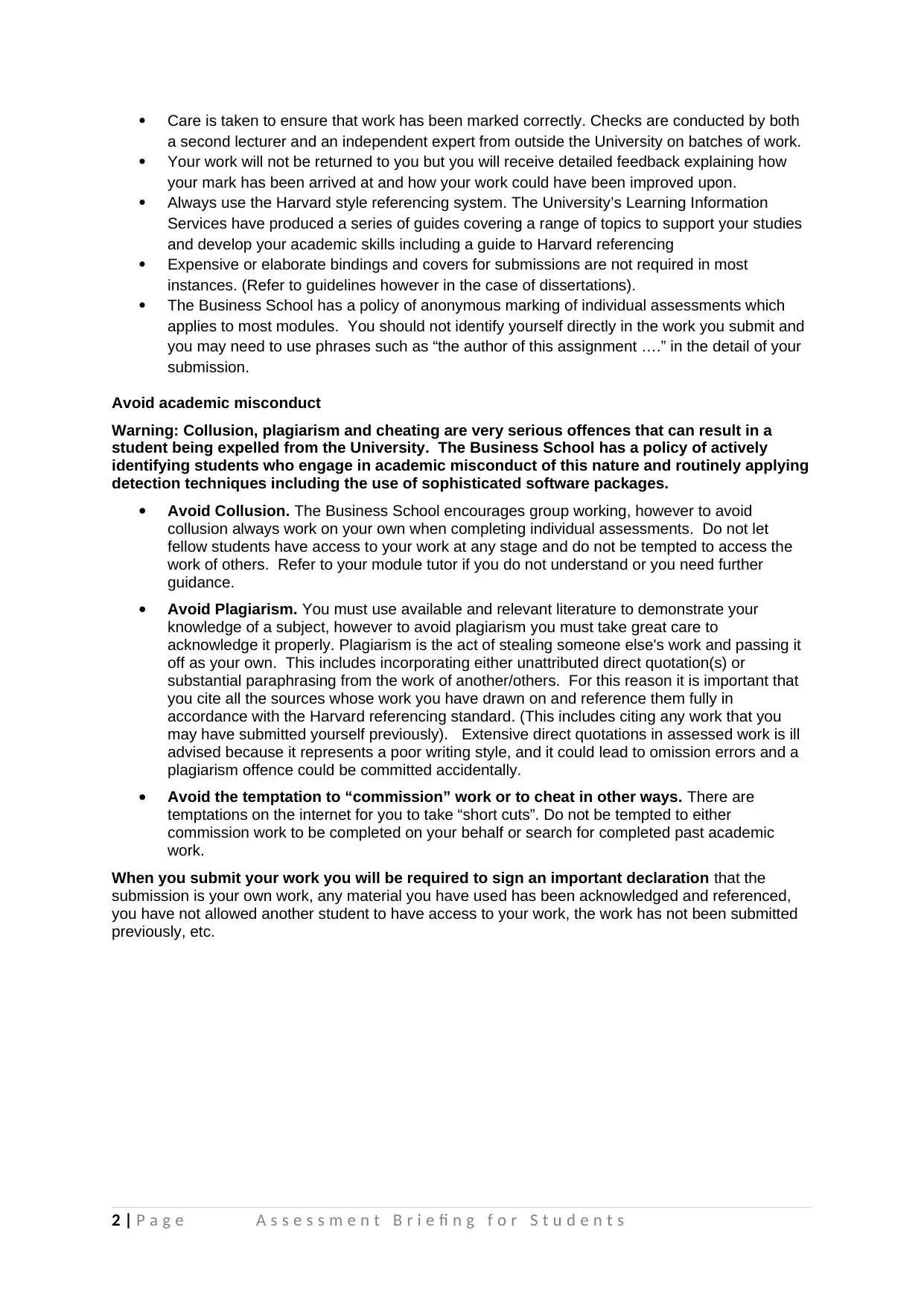
Care is taken to ensure that work has been marked correctly. Checks are conducted by both
a second lecturer and an independent expert from outside the University on batches of work.
Your work will not be returned to you but you will receive detailed feedback explaining how
your mark has been arrived at and how your work could have been improved upon.
Always use the Harvard style referencing system. The University’s Learning Information
Services have produced a series of guides covering a range of topics to support your studies
and develop your academic skills including a guide to Harvard referencing
Expensive or elaborate bindings and covers for submissions are not required in most
instances. (Refer to guidelines however in the case of dissertations).
The Business School has a policy of anonymous marking of individual assessments which
applies to most modules. You should not identify yourself directly in the work you submit and
you may need to use phrases such as “the author of this assignment ….” in the detail of your
submission.
Avoid academic misconduct
Warning: Collusion, plagiarism and cheating are very serious offences that can result in a
student being expelled from the University. The Business School has a policy of actively
identifying students who engage in academic misconduct of this nature and routinely applying
detection techniques including the use of sophisticated software packages.
Avoid Collusion. The Business School encourages group working, however to avoid
collusion always work on your own when completing individual assessments. Do not let
fellow students have access to your work at any stage and do not be tempted to access the
work of others. Refer to your module tutor if you do not understand or you need further
guidance.
Avoid Plagiarism. You must use available and relevant literature to demonstrate your
knowledge of a subject, however to avoid plagiarism you must take great care to
acknowledge it properly. Plagiarism is the act of stealing someone else's work and passing it
off as your own. This includes incorporating either unattributed direct quotation(s) or
substantial paraphrasing from the work of another/others. For this reason it is important that
you cite all the sources whose work you have drawn on and reference them fully in
accordance with the Harvard referencing standard. (This includes citing any work that you
may have submitted yourself previously). Extensive direct quotations in assessed work is ill
advised because it represents a poor writing style, and it could lead to omission errors and a
plagiarism offence could be committed accidentally.
Avoid the temptation to “commission” work or to cheat in other ways. There are
temptations on the internet for you to take “short cuts”. Do not be tempted to either
commission work to be completed on your behalf or search for completed past academic
work.
When you submit your work you will be required to sign an important declaration that the
submission is your own work, any material you have used has been acknowledged and referenced,
you have not allowed another student to have access to your work, the work has not been submitted
previously, etc.
2 | P a g e A s s e s s m e n t B r i e fi n g f o r S t u d e n t s
a second lecturer and an independent expert from outside the University on batches of work.
Your work will not be returned to you but you will receive detailed feedback explaining how
your mark has been arrived at and how your work could have been improved upon.
Always use the Harvard style referencing system. The University’s Learning Information
Services have produced a series of guides covering a range of topics to support your studies
and develop your academic skills including a guide to Harvard referencing
Expensive or elaborate bindings and covers for submissions are not required in most
instances. (Refer to guidelines however in the case of dissertations).
The Business School has a policy of anonymous marking of individual assessments which
applies to most modules. You should not identify yourself directly in the work you submit and
you may need to use phrases such as “the author of this assignment ….” in the detail of your
submission.
Avoid academic misconduct
Warning: Collusion, plagiarism and cheating are very serious offences that can result in a
student being expelled from the University. The Business School has a policy of actively
identifying students who engage in academic misconduct of this nature and routinely applying
detection techniques including the use of sophisticated software packages.
Avoid Collusion. The Business School encourages group working, however to avoid
collusion always work on your own when completing individual assessments. Do not let
fellow students have access to your work at any stage and do not be tempted to access the
work of others. Refer to your module tutor if you do not understand or you need further
guidance.
Avoid Plagiarism. You must use available and relevant literature to demonstrate your
knowledge of a subject, however to avoid plagiarism you must take great care to
acknowledge it properly. Plagiarism is the act of stealing someone else's work and passing it
off as your own. This includes incorporating either unattributed direct quotation(s) or
substantial paraphrasing from the work of another/others. For this reason it is important that
you cite all the sources whose work you have drawn on and reference them fully in
accordance with the Harvard referencing standard. (This includes citing any work that you
may have submitted yourself previously). Extensive direct quotations in assessed work is ill
advised because it represents a poor writing style, and it could lead to omission errors and a
plagiarism offence could be committed accidentally.
Avoid the temptation to “commission” work or to cheat in other ways. There are
temptations on the internet for you to take “short cuts”. Do not be tempted to either
commission work to be completed on your behalf or search for completed past academic
work.
When you submit your work you will be required to sign an important declaration that the
submission is your own work, any material you have used has been acknowledged and referenced,
you have not allowed another student to have access to your work, the work has not been submitted
previously, etc.
2 | P a g e A s s e s s m e n t B r i e fi n g f o r S t u d e n t s
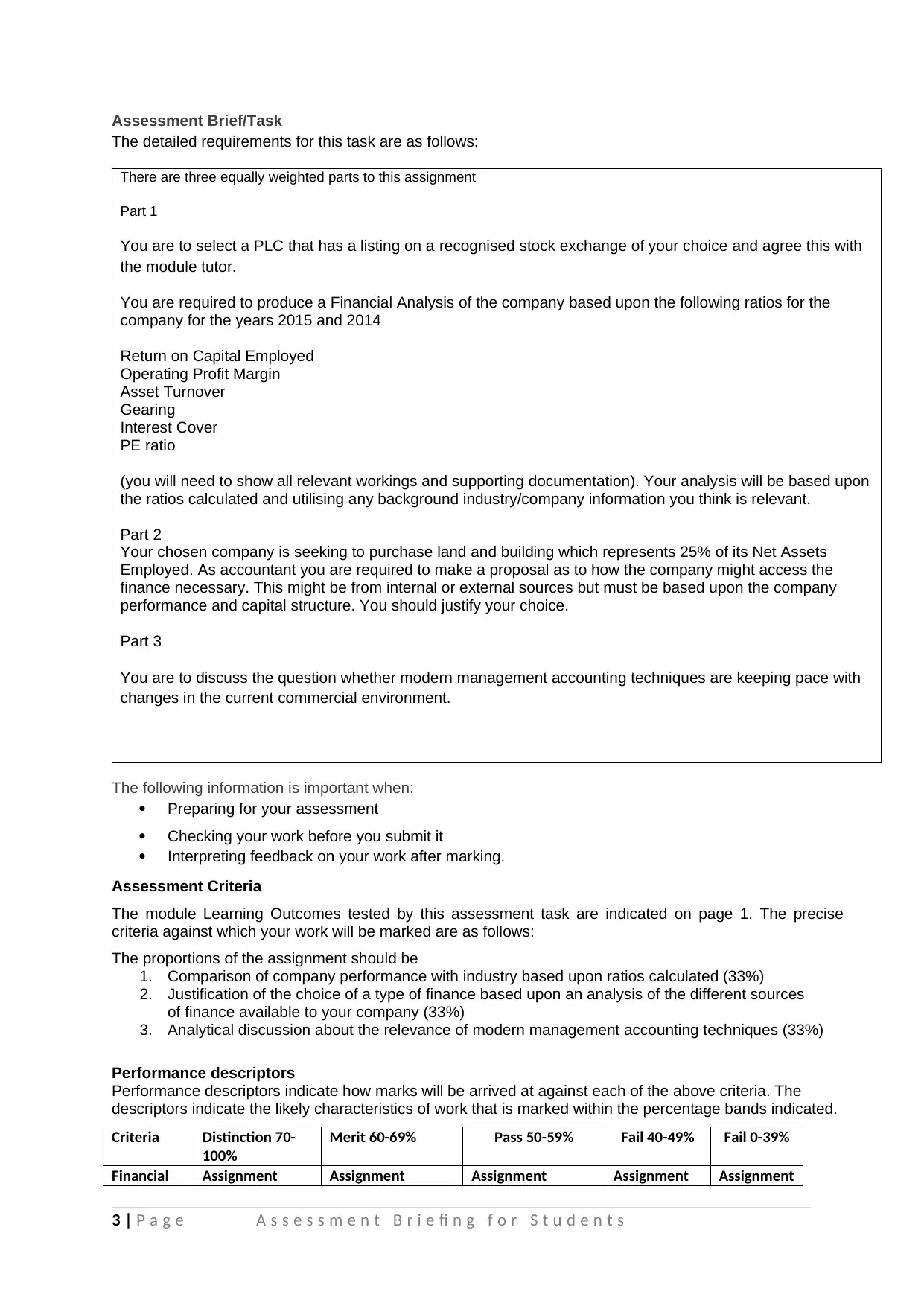
Assessment Brief/Task
The detailed requirements for this task are as follows:
There are three equally weighted parts to this assignment
Part 1
You are to select a PLC that has a listing on a recognised stock exchange of your choice and agree this with
the module tutor.
You are required to produce a Financial Analysis of the company based upon the following ratios for the
company for the years 2015 and 2014
Return on Capital Employed
Operating Profit Margin
Asset Turnover
Gearing
Interest Cover
PE ratio
(you will need to show all relevant workings and supporting documentation). Your analysis will be based upon
the ratios calculated and utilising any background industry/company information you think is relevant.
Part 2
Your chosen company is seeking to purchase land and building which represents 25% of its Net Assets
Employed. As accountant you are required to make a proposal as to how the company might access the
finance necessary. This might be from internal or external sources but must be based upon the company
performance and capital structure. You should justify your choice.
Part 3
You are to discuss the question whether modern management accounting techniques are keeping pace with
changes in the current commercial environment.
The following information is important when:
Preparing for your assessment
Checking your work before you submit it
Interpreting feedback on your work after marking.
Assessment Criteria
The module Learning Outcomes tested by this assessment task are indicated on page 1. The precise
criteria against which your work will be marked are as follows:
The proportions of the assignment should be
1. Comparison of company performance with industry based upon ratios calculated (33%)
2. Justification of the choice of a type of finance based upon an analysis of the different sources
of finance available to your company (33%)
3. Analytical discussion about the relevance of modern management accounting techniques (33%)
Performance descriptors
Performance descriptors indicate how marks will be arrived at against each of the above criteria. The
descriptors indicate the likely characteristics of work that is marked within the percentage bands indicated.
Criteria Distinction 70-
100%
Merit 60-69% Pass 50-59% Fail 40-49% Fail 0-39%
Financial Assignment Assignment Assignment Assignment Assignment
3 | P a g e A s s e s s m e n t B r i e fi n g f o r S t u d e n t s
The detailed requirements for this task are as follows:
There are three equally weighted parts to this assignment
Part 1
You are to select a PLC that has a listing on a recognised stock exchange of your choice and agree this with
the module tutor.
You are required to produce a Financial Analysis of the company based upon the following ratios for the
company for the years 2015 and 2014
Return on Capital Employed
Operating Profit Margin
Asset Turnover
Gearing
Interest Cover
PE ratio
(you will need to show all relevant workings and supporting documentation). Your analysis will be based upon
the ratios calculated and utilising any background industry/company information you think is relevant.
Part 2
Your chosen company is seeking to purchase land and building which represents 25% of its Net Assets
Employed. As accountant you are required to make a proposal as to how the company might access the
finance necessary. This might be from internal or external sources but must be based upon the company
performance and capital structure. You should justify your choice.
Part 3
You are to discuss the question whether modern management accounting techniques are keeping pace with
changes in the current commercial environment.
The following information is important when:
Preparing for your assessment
Checking your work before you submit it
Interpreting feedback on your work after marking.
Assessment Criteria
The module Learning Outcomes tested by this assessment task are indicated on page 1. The precise
criteria against which your work will be marked are as follows:
The proportions of the assignment should be
1. Comparison of company performance with industry based upon ratios calculated (33%)
2. Justification of the choice of a type of finance based upon an analysis of the different sources
of finance available to your company (33%)
3. Analytical discussion about the relevance of modern management accounting techniques (33%)
Performance descriptors
Performance descriptors indicate how marks will be arrived at against each of the above criteria. The
descriptors indicate the likely characteristics of work that is marked within the percentage bands indicated.
Criteria Distinction 70-
100%
Merit 60-69% Pass 50-59% Fail 40-49% Fail 0-39%
Financial Assignment Assignment Assignment Assignment Assignment
3 | P a g e A s s e s s m e n t B r i e fi n g f o r S t u d e n t s
⊘ This is a preview!⊘
Do you want full access?
Subscribe today to unlock all pages.

Trusted by 1+ million students worldwide
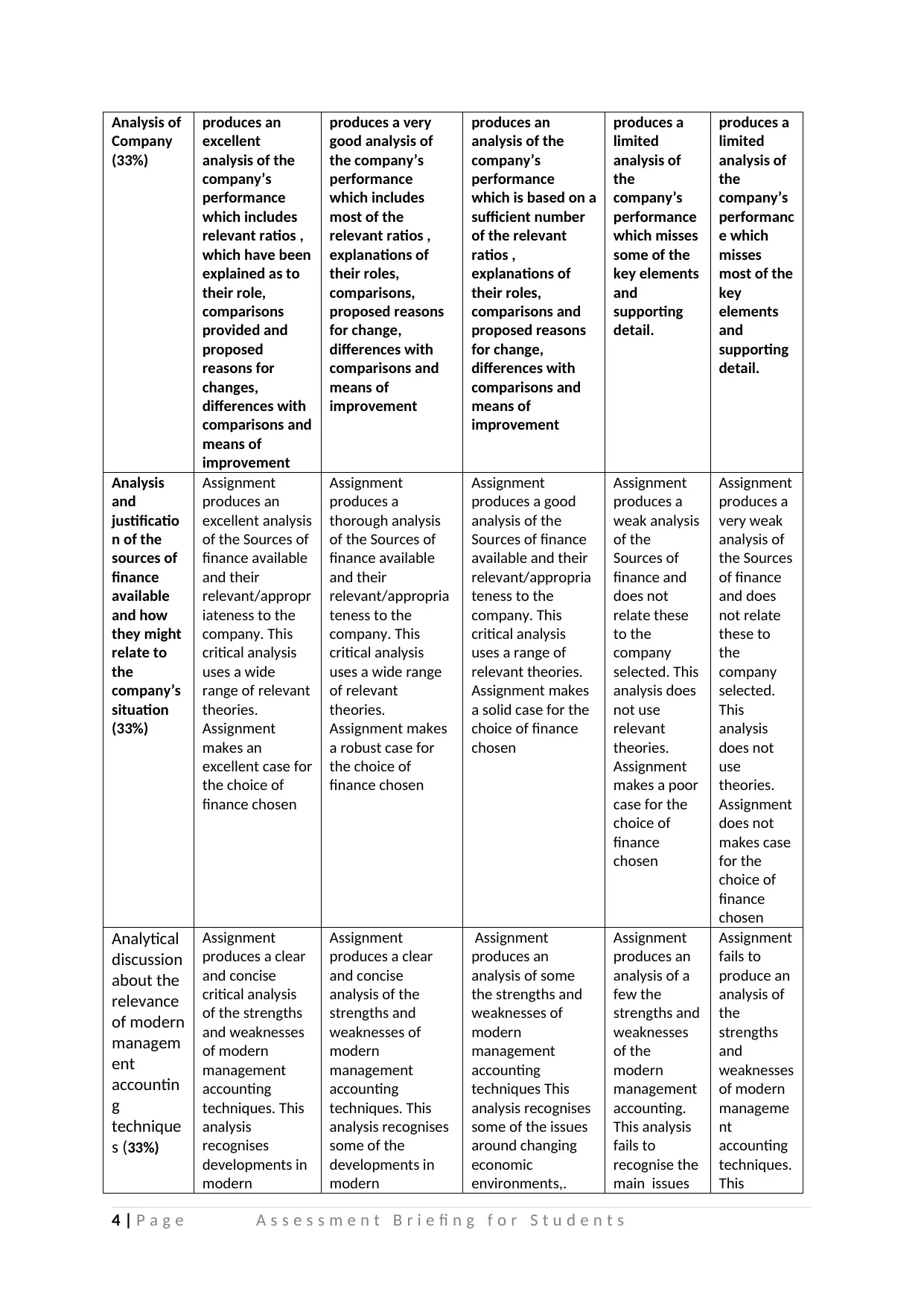
Analysis of
Company
(33%)
produces an
excellent
analysis of the
company’s
performance
which includes
relevant ratios ,
which have been
explained as to
their role,
comparisons
provided and
proposed
reasons for
changes,
differences with
comparisons and
means of
improvement
produces a very
good analysis of
the company’s
performance
which includes
most of the
relevant ratios ,
explanations of
their roles,
comparisons,
proposed reasons
for change,
differences with
comparisons and
means of
improvement
produces an
analysis of the
company’s
performance
which is based on a
sufficient number
of the relevant
ratios ,
explanations of
their roles,
comparisons and
proposed reasons
for change,
differences with
comparisons and
means of
improvement
produces a
limited
analysis of
the
company’s
performance
which misses
some of the
key elements
and
supporting
detail.
produces a
limited
analysis of
the
company’s
performanc
e which
misses
most of the
key
elements
and
supporting
detail.
Analysis
and
justificatio
n of the
sources of
finance
available
and how
they might
relate to
the
company’s
situation
(33%)
Assignment
produces an
excellent analysis
of the Sources of
finance available
and their
relevant/appropr
iateness to the
company. This
critical analysis
uses a wide
range of relevant
theories.
Assignment
makes an
excellent case for
the choice of
finance chosen
Assignment
produces a
thorough analysis
of the Sources of
finance available
and their
relevant/appropria
teness to the
company. This
critical analysis
uses a wide range
of relevant
theories.
Assignment makes
a robust case for
the choice of
finance chosen
Assignment
produces a good
analysis of the
Sources of finance
available and their
relevant/appropria
teness to the
company. This
critical analysis
uses a range of
relevant theories.
Assignment makes
a solid case for the
choice of finance
chosen
Assignment
produces a
weak analysis
of the
Sources of
finance and
does not
relate these
to the
company
selected. This
analysis does
not use
relevant
theories.
Assignment
makes a poor
case for the
choice of
finance
chosen
Assignment
produces a
very weak
analysis of
the Sources
of finance
and does
not relate
these to
the
company
selected.
This
analysis
does not
use
theories.
Assignment
does not
makes case
for the
choice of
finance
chosen
Analytical
discussion
about the
relevance
of modern
managem
ent
accountin
g
technique
s (33%)
Assignment
produces a clear
and concise
critical analysis
of the strengths
and weaknesses
of modern
management
accounting
techniques. This
analysis
recognises
developments in
modern
Assignment
produces a clear
and concise
analysis of the
strengths and
weaknesses of
modern
management
accounting
techniques. This
analysis recognises
some of the
developments in
modern
Assignment
produces an
analysis of some
the strengths and
weaknesses of
modern
management
accounting
techniques This
analysis recognises
some of the issues
around changing
economic
environments,.
Assignment
produces an
analysis of a
few the
strengths and
weaknesses
of the
modern
management
accounting.
This analysis
fails to
recognise the
main issues
Assignment
fails to
produce an
analysis of
the
strengths
and
weaknesses
of modern
manageme
nt
accounting
techniques.
This
4 | P a g e A s s e s s m e n t B r i e fi n g f o r S t u d e n t s
Company
(33%)
produces an
excellent
analysis of the
company’s
performance
which includes
relevant ratios ,
which have been
explained as to
their role,
comparisons
provided and
proposed
reasons for
changes,
differences with
comparisons and
means of
improvement
produces a very
good analysis of
the company’s
performance
which includes
most of the
relevant ratios ,
explanations of
their roles,
comparisons,
proposed reasons
for change,
differences with
comparisons and
means of
improvement
produces an
analysis of the
company’s
performance
which is based on a
sufficient number
of the relevant
ratios ,
explanations of
their roles,
comparisons and
proposed reasons
for change,
differences with
comparisons and
means of
improvement
produces a
limited
analysis of
the
company’s
performance
which misses
some of the
key elements
and
supporting
detail.
produces a
limited
analysis of
the
company’s
performanc
e which
misses
most of the
key
elements
and
supporting
detail.
Analysis
and
justificatio
n of the
sources of
finance
available
and how
they might
relate to
the
company’s
situation
(33%)
Assignment
produces an
excellent analysis
of the Sources of
finance available
and their
relevant/appropr
iateness to the
company. This
critical analysis
uses a wide
range of relevant
theories.
Assignment
makes an
excellent case for
the choice of
finance chosen
Assignment
produces a
thorough analysis
of the Sources of
finance available
and their
relevant/appropria
teness to the
company. This
critical analysis
uses a wide range
of relevant
theories.
Assignment makes
a robust case for
the choice of
finance chosen
Assignment
produces a good
analysis of the
Sources of finance
available and their
relevant/appropria
teness to the
company. This
critical analysis
uses a range of
relevant theories.
Assignment makes
a solid case for the
choice of finance
chosen
Assignment
produces a
weak analysis
of the
Sources of
finance and
does not
relate these
to the
company
selected. This
analysis does
not use
relevant
theories.
Assignment
makes a poor
case for the
choice of
finance
chosen
Assignment
produces a
very weak
analysis of
the Sources
of finance
and does
not relate
these to
the
company
selected.
This
analysis
does not
use
theories.
Assignment
does not
makes case
for the
choice of
finance
chosen
Analytical
discussion
about the
relevance
of modern
managem
ent
accountin
g
technique
s (33%)
Assignment
produces a clear
and concise
critical analysis
of the strengths
and weaknesses
of modern
management
accounting
techniques. This
analysis
recognises
developments in
modern
Assignment
produces a clear
and concise
analysis of the
strengths and
weaknesses of
modern
management
accounting
techniques. This
analysis recognises
some of the
developments in
modern
Assignment
produces an
analysis of some
the strengths and
weaknesses of
modern
management
accounting
techniques This
analysis recognises
some of the issues
around changing
economic
environments,.
Assignment
produces an
analysis of a
few the
strengths and
weaknesses
of the
modern
management
accounting.
This analysis
fails to
recognise the
main issues
Assignment
fails to
produce an
analysis of
the
strengths
and
weaknesses
of modern
manageme
nt
accounting
techniques.
This
4 | P a g e A s s e s s m e n t B r i e fi n g f o r S t u d e n t s
Paraphrase This Document
Need a fresh take? Get an instant paraphrase of this document with our AI Paraphraser
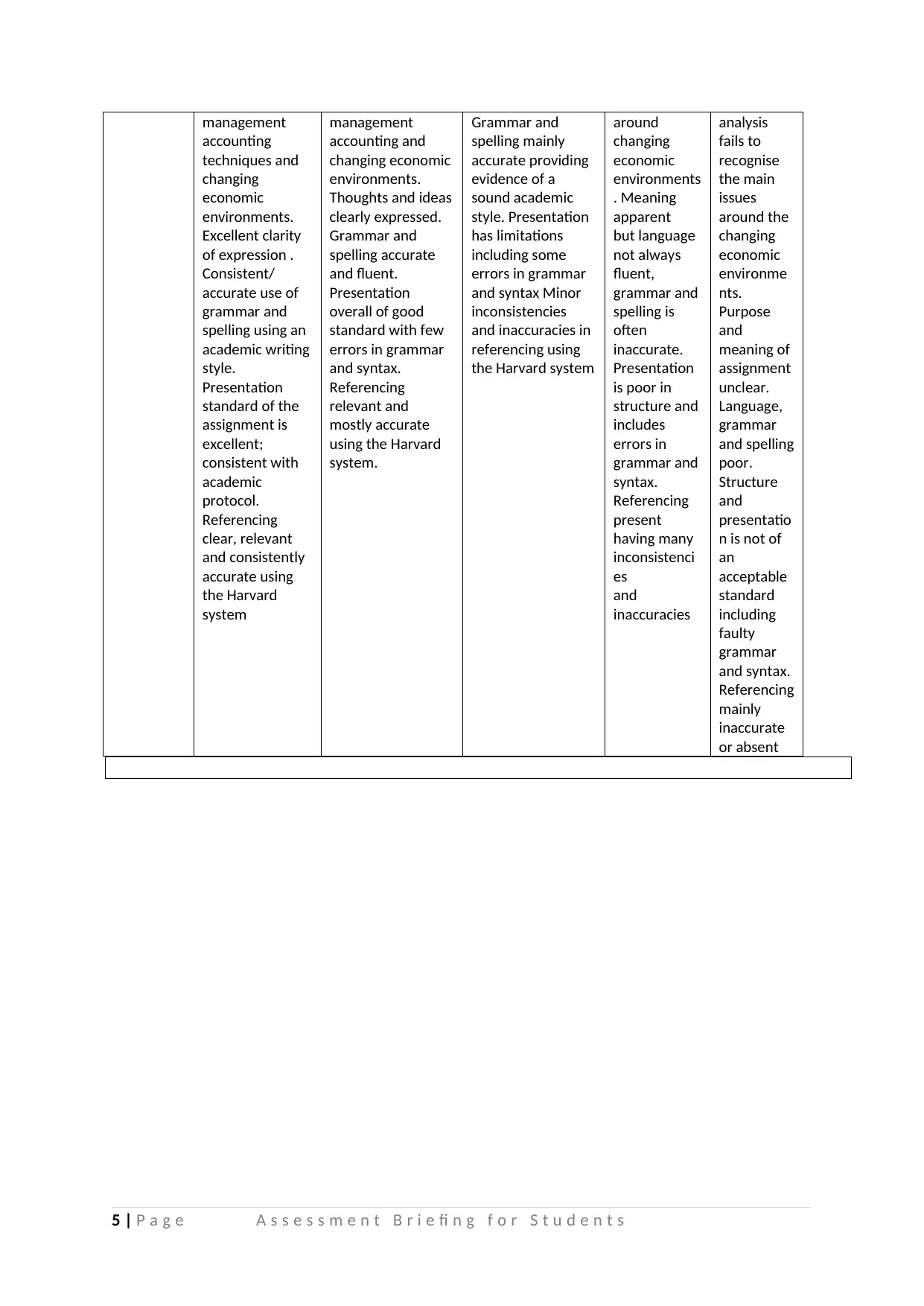
management
accounting
techniques and
changing
economic
environments.
Excellent clarity
of expression .
Consistent/
accurate use of
grammar and
spelling using an
academic writing
style.
Presentation
standard of the
assignment is
excellent;
consistent with
academic
protocol.
Referencing
clear, relevant
and consistently
accurate using
the Harvard
system
management
accounting and
changing economic
environments.
Thoughts and ideas
clearly expressed.
Grammar and
spelling accurate
and fluent.
Presentation
overall of good
standard with few
errors in grammar
and syntax.
Referencing
relevant and
mostly accurate
using the Harvard
system.
Grammar and
spelling mainly
accurate providing
evidence of a
sound academic
style. Presentation
has limitations
including some
errors in grammar
and syntax Minor
inconsistencies
and inaccuracies in
referencing using
the Harvard system
around
changing
economic
environments
. Meaning
apparent
but language
not always
fluent,
grammar and
spelling is
often
inaccurate.
Presentation
is poor in
structure and
includes
errors in
grammar and
syntax.
Referencing
present
having many
inconsistenci
es
and
inaccuracies
analysis
fails to
recognise
the main
issues
around the
changing
economic
environme
nts.
Purpose
and
meaning of
assignment
unclear.
Language,
grammar
and spelling
poor.
Structure
and
presentatio
n is not of
an
acceptable
standard
including
faulty
grammar
and syntax.
Referencing
mainly
inaccurate
or absent
5 | P a g e A s s e s s m e n t B r i e fi n g f o r S t u d e n t s
accounting
techniques and
changing
economic
environments.
Excellent clarity
of expression .
Consistent/
accurate use of
grammar and
spelling using an
academic writing
style.
Presentation
standard of the
assignment is
excellent;
consistent with
academic
protocol.
Referencing
clear, relevant
and consistently
accurate using
the Harvard
system
management
accounting and
changing economic
environments.
Thoughts and ideas
clearly expressed.
Grammar and
spelling accurate
and fluent.
Presentation
overall of good
standard with few
errors in grammar
and syntax.
Referencing
relevant and
mostly accurate
using the Harvard
system.
Grammar and
spelling mainly
accurate providing
evidence of a
sound academic
style. Presentation
has limitations
including some
errors in grammar
and syntax Minor
inconsistencies
and inaccuracies in
referencing using
the Harvard system
around
changing
economic
environments
. Meaning
apparent
but language
not always
fluent,
grammar and
spelling is
often
inaccurate.
Presentation
is poor in
structure and
includes
errors in
grammar and
syntax.
Referencing
present
having many
inconsistenci
es
and
inaccuracies
analysis
fails to
recognise
the main
issues
around the
changing
economic
environme
nts.
Purpose
and
meaning of
assignment
unclear.
Language,
grammar
and spelling
poor.
Structure
and
presentatio
n is not of
an
acceptable
standard
including
faulty
grammar
and syntax.
Referencing
mainly
inaccurate
or absent
5 | P a g e A s s e s s m e n t B r i e fi n g f o r S t u d e n t s
1 out of 5
Related Documents
Your All-in-One AI-Powered Toolkit for Academic Success.
+13062052269
info@desklib.com
Available 24*7 on WhatsApp / Email
![[object Object]](/_next/static/media/star-bottom.7253800d.svg)
Unlock your academic potential
Copyright © 2020–2025 A2Z Services. All Rights Reserved. Developed and managed by ZUCOL.





